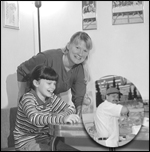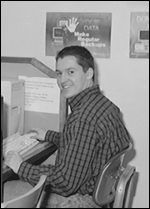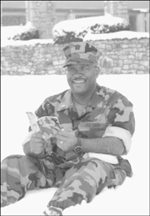The print version of this story includes extensive charts. To view them, click the “download PDF” button above.
Consider the typical student of theology: 48.2 percent married, 1.6 percent Ph.D. holder, 10.2 percent black, 9.9 percent Asian, 74.7 percent white, 37.7 percent female—hard to envision. All right, then—consider the fact that there hasn’t been a typical student of theology in quite some time. What’s more, there is no perfect profile of seminarians to be had. There are, however, snapshots of the current crop of students available in the form of surveys that address questions ranging from the religious traditions in which students were raised to the educational levels of their parents.
What do you know about the diversity of your own student body? What are the trends both in terms of simple demographics—age, gender, and ethnic identity—and in terms of their backgrounds, expectations of seminary, and hopes and plans for the future? What thought have you given to what you need to know about your students and students in other theological schools? Does your school have a specific mission, and do the students you attract fit that niche?
The Association of Theological Schools’ Student Information Project has a wealth of information about entering students and graduates over the last five years. This year 106 schools opted into the program (at costs ranging upward from $150 for schools with fewer than twenty-five students). The entering student questionnaire has thirty-six standard items and can include up to five of the school’s own design.
Francis Lonsway, the project director, is eager to get the information in a form that will be helpful to schools. The questionnaire is tweaked year by year. For example, the time has come for “via the school’s website” to join the lineup of possibilities under “first contact with the school.”
Following the links at the ATS website <www.ats.edu> will lead to reports on the data and an online newsletter with information on how other schools are putting it to use. Participating schools get the combined data as well as their own, plus a one-page summary of particularly striking results from their own students. They are also eligible to participate in workshops that seek to explain how data can best be utilized in planning.
“The data is full of surprises,” said Lonsway. “For example, a school might think of itself as fairly conservative—but its students may think of it as a liberal place. That’s important information.”
Lonsway also stresses the importance of thoughtful interpretation of data. He notes that some schools have been working hard at recruiting younger students on the assumption that they will spend more years in ministry (an apparently successful endeavor as the average age of students shows signs of inching down). Perhaps that assumption is good, said Lonsway, but data also show that younger students are less interested in parish ministry than older ones—and less ethnically diverse besides.
Another study of new theology students, commissioned by the Fund for Theological Education and run by the Auburn Center for the Study of Theological Education, will be published early in the new year. A total of 2,500 students from 161 schools responded to a detailed survey last spring. The report on the study will be available through the Center’s website at www.auburnsem.org.
When you look at data, don’t forget that the numbers on the charts (to view them, click the “download PDF” button above) are about real students, who come with real and varied stories. In Trust spent some time with students at Midwestern Baptist Theological Seminary, a school of the Southern Baptist Convention located in Kansas City, Missouri. These students serve as illustrations of some of the more arresting statistics from the ATS and Auburn data, but their stories are full of the twists and quirks that give life to the numbers. Your students have their own stories. If you know them well, you will better understand your school’s mission and will be better equipped to plan its future.

|
| Dawn Friesen, pictured here, gave up an exotic animals business and the home it was housed in to come to seminary. Her husband Don went from management to labor. One of his three jobs is that of confectionery baker; here he’s applying a butter-cream icing.
Photograph by J. Kent Dixler
|
Don and Dawn Friesen: Working almost around the clock
Don Friesen gets up early. At 3 a.m., he’s baking for a grocery store—one of the grocery store bakeries he managed for the fourteen years before he and his wife felt a call to prepare for mission work among young people in Brazil by becoming seminarians. He heads off for classes at Midwestern later in the morning—where he meets his wife Dawn, who is taking the same classes he is. After classes, their paths diverge as she returns home to home school their 10- and 13-year-old daughters and he heads off to complete his eight-hour bakery shift before heading to a few more hours of work on a construction job. The family might meet later at one of the activities that are part of his third job as youth minister at Trinity North Baptist Church.
Communication was the biggest challenge for the family when they started seminary, said Don. Dawn had run a business from home in their previous lives, and Don was working only one full-time job. “But although actual time for conversation is in short supply now,” he said, “we know why we’re doing what we’re doing—and the shared element makes it work.”
Not every seminarian is quite so busy—or quite so driven: the Friesens have a limited window of time in which to pursue the mission post to which they believe they have been called. But lots of seminarians are working long hours and facing daunting commutes to finish their schooling. One in ten full-time M.Div. students, for example, has a commute to school that takes more than an hour.
Sometimes this means that seminary education isn’t completed quickly. The Friesens are—astonishingly—managing full-time course loads now. Their seminary careers will be slowed, however, when they leave for their two-year stint in Brazil. Slowed, but not stalled—they will take extension courses on a part-time basis until they return to complete their degrees. There is, not surprisingly, a correlation between the number of dependants a student has and how long it takes that student to complete theological studies.
Jim Orrick: Prepared by life and the academy
“When people hear that I have a Ph.D. in English literature, they usually assume that I was called to the ministry from academia,” said Jim Orrick, now a student at Midwestern, “but, in fact, I was preaching right out of high school.” His life path has taken him through a variety of church positions: an interest in missions led him to a degree in teaching English as a second language—and a love of teaching took him through the doctoral program at Ohio University while he pastored a small church in Buffalo, West Virginia. His first love, though, is the ministry, and that call eventually led him to seminary.
The message here is that it isn’t entirely fair to make assumptions about a student’s preparedness for seminary based on a previous major. Just one in five incoming seminarians in the ATS study had a degree in religion or theology, although the Auburn/FTE study found younger students twice as likely as older ones to have these majors. On the other hand, younger students are much less likely compared to their over-30 counterparts to describe themselves as having been very active in a worship community.
Shane Pennington: The collegiate experience
Even the direct route to seminary can be a little convoluted. Shane Pennington came to seminary almost straight from college. He first became convinced of a call to ministry the summer he graduated from high school, but he was already enrolled as an agronomy major at Cameron University, a part of the Oklahoma state system. He transferred after a semester to Oklahoma Baptist University’s pastoral ministry major, but during his first class, a professor said, “Ninety-nine percent of you are going to graduate and come back to churches in the Bible belt. There’s a world out there that needs God and you need to pray about whether God might be calling you somewhere else.” Pennington did and changed his major to missions. He still hopes to do ministry in another country after he graduates, but his life took another twist in the meantime.

|
| Shane Pennington’s campus pastor played a key role in helping him choose a seminary. Midwestern Baptist Theological Seminary was his choice.
Photograph by J. Kent Dixler
|
His involvement with campus ministry at OBU began with community outreach activities he didn’t even know were sponsored by campus ministry. “I met my wife when we both volunteered to play with kids with cerebral palsy one night a week,” he recalled. Somehow his activity level caught the eye of the campus ministry, and he was elected to a leadership position, which led to a part-time job, which led to a full-time job upon graduation. “My wife and I had planned to go straight to the missions, but we didn’t know about the rule about not going out for a year after you married,” he said. “But I got the offer to work in campus ministry, and then we heard about Midwestern’s Collegiate Ministry program, which you begin while doing campus ministry and finish at the seminary.” He learned of the program from his campus pastor, who learned of it from a pastor at a nearby college.
“I will almost graduate in May,” said Pennington. He has just a couple of courses to complete, but he also has a job with a new church. He still plans to take his degree in collegiate ministry to the mission field. “I’m not sure where or in what capacity,” he said, “but we’ll be ready.”
 |
| In high school, James Redmond imagined serving as a medical missionary. He’s changed directions a few times since then, but is still working toward a nonparish-based ministry.
Photograph by
J. Kent Dixler
|
James Redmond: The long road to where?
Some calls come with blinding specificity. Many do not. “One thing I came here planning to do was military chaplaincy,” said James Redmond. Indeed, his seminary career has been interspersed with Navy chaplain training and basic officer training, which Redmond described as “two weeks of marching out in the woods.” But as graduation approaches, he’s wondering if it is fair to leave his family, which includes a 7-year-old daughter, for an extended tour of duty. “Maybe I’ll do reserve duty, and I’ve developed an interest in correctional chaplaincy.”
He knows firsthand the rigors of military life; he spent three and a half years on active duty as a radar technician in the 1980s. “I spent a lot of time with the chaplain on the ship,” he said. “Sometimes I was the only person to show up.”
After his tour of duty, he went home to Oklahoma, took some college courses, got married, worked for a while as house parent in a children’s home, then moved to St. Louis to help start a church while finishing a B.A. in religion. He moved to Dallas, where he attempted to work full time while attending Dallas Theological Seminary full time—which quickly led to burnout. He stayed in town for another year, working for the seminary, and then moved to Kansas City and enrolled at Midwestern. “It’s a smaller school, and we could live on campus,” he said. “Those things were important to us.”
Now he’s about to graduate, and the future has not yet come into focus. Redmond isn’t overly alarmed, though, and he has a sense of perspective. “Wherever I go,” he said, “I’ll use everything I’ve learned.”